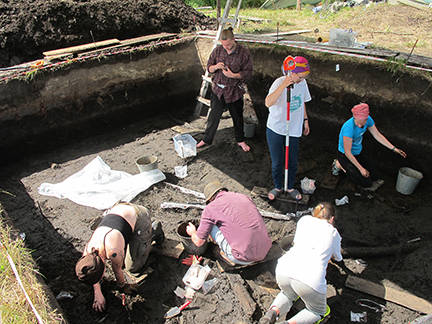On the monument of Sertey II in the layer 5–4 thousand BC. e. a shaft of a spear-throwing dart in the form of a snake was found — an exceptional object for the culture of the Stone Age, which has no analogues in Russian archeology.
Thanks to skillful work with the structure of the tree, the master managed to imitate the scales and movements of a snake. The body has side cuts, and at the end of the shaft there is a head with an open mouth and scorched black eyes. Initially, instead of a sting, a tip was inserted into the open mouth. It was lost during hunting or ritual activities on the shore of an ancient lake. This is evidenced by the archaeological context — a dart was found stuck in a layer of ancient bottom sediments.
Research on pile settlements in northwestern Russia is inextricably linked with the name of Alexander Mikhailovich Miklyaev, a leading researcher in the Department of Archeology of Eastern Europe and Siberia of the State Hermitage Museum, who discovered and first studied these settlements in 1963.
Contemporary research by the State Hermitage’s Northwest Expedition is supported, among other things, by a grant from the Russian Science Foundation (project no. 22–18–00086 “Between East and West: hunter-gatherers of the lake region in Western Russia in 7–3 thousand BC (economic strategies, cultural traditions, interregional relationships and paleoecological conditions)”.
Supported by the History of the Fatherland Foundation under the project Stone Age Pile Settlements in the North-West of Russia: Underwater and Complex Research. On the occasion of the 60th anniversary of the discovery” a field school worked within the framework of the expedition. It was attended by young people from St. Petersburg, Tomsk, Kazan, Tyumen, Veliky Novgorod, Moscow, Vologda and Omsk.
- Mongolia
- Haruto Takahashi Found Pirate Treasure in Madagascar
- Indonesia
- Decline in international tourism to the US: causes and consequences
- Pirate places of the world: where to travel for seafaring legends
- Tourist places where Hemingway went
- Unadsdalur Church
- Treasure in the Cape Cod fog: A Thai traveler’s encounter with pirate history
- Leonardo DiCaprio: tourist places of his life and filming
- Gibraltar
- Normandy
- Evacuation of Kyiv icons takes fight for Ukraine’s heritage to Louvre in Paris
- Sydney
- In the footsteps of Pinocchio: a journey through the wooden boy’s world
- Chile
- Norway’s Atlantic Road scenic drive
- Uluṟu-Kata Tjuṯa and Kakadu National Parks Etched in Time
- Teatime at Cape Town’s 5‑Star Mount Nelson Hotel
- Dagestan
- Sumatra











